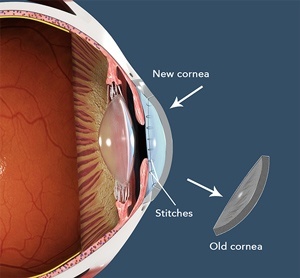66 Pacific Hwy
ST LEONARDS NSW 2065
Fax: 02-8412 0060

A corneal transplant or keratoplasty is a surgical procedure performed to replace all or a part of the damaged cornea with corneal tissue received from a healthy donor. The cornea is a clear and protective dome-shaped covering over the iris (coloured part of the eye) and the pupil (small central black circle in the iris) of the eye made up of six delicate layers.
The cornea acts as a lens and helps in projecting light onto the retina (light-sensitive layer at the back of the eye). Damaged or diseased cornea may change the shape and reduce transparency of the cornea, which can disrupt the projection of light and result in impaired vision. A cornea transplant can treat severe infection or damage, relieve pain and improve vision.
Conditions that require corneal transplant include:
Corneal transplant procedures will be carried out depending on which part of the cornea needs to be replaced, and will be performed under general or local anaesthesia.
Full thickness corneal transplants or penetrating keratoplasty
Penetrating keratoplasty involves the removal of the damaged corneal area and replacing it with a donated cornea. Your surgeon will use a circular cutting instrument called as a trephine to cut through the thickness of the damaged cornea. The new cornea will be placed and sutured with tiny stitches around its edges.
Partial thickness corneal transplants
Partial thickness transplant involves the transplantation of only parts of the cornea. The techniques depend on which layers of the cornea have to be transplanted – the front or back portion of the cornea.
In both of these procedures, the donor cornea is fixed in place with stitches.
In both of these procedures, the replaced corneal tissues are held with the help of a temporary air bubble instead of stiches.
After the transplant, your doctor may cover your eyes with an eye pad or plastic shield, which may be removed after a day of the procedure. You will have to wear a patch for few weeks at night after the surgery. You may experience blurring of vision, swelling and discomfort after the procedure. After a partial-thickness transplant, you may have to lie on your back for 1-2 days after the surgery so that the bubble holds the transplanted corneal tissues in the correct place.
You will have to instil steroid or antibiotic eye drops daily, for many months or even more than a year to prevent infection and rejection, and reduce inflammation and swelling. Avoid heavy lifting and strenuous exercise for few weeks after surgery. Do not rub your eyes. Wear sunglasses if your eyes are light sensitive. You can resume contact sports and swimming only after consulting your doctor.
As with any surgery, cornea transplant involves potential risks and complications. The common risk of cornea transplant is the rejection of donor cornea. Consult your doctor immediately if you notice symptoms of rejection such as vision problems (cloudy or foggy vision), pain, redness and light sensitivity. Other complications include:
After a cornea transplant, the time taken for your vision to return depends on the type of procedure performed. Before the vision settles, you may experience vision fluctuations between better or worse. Even after the vision returns, you may require corrective lenses or further treatment.














